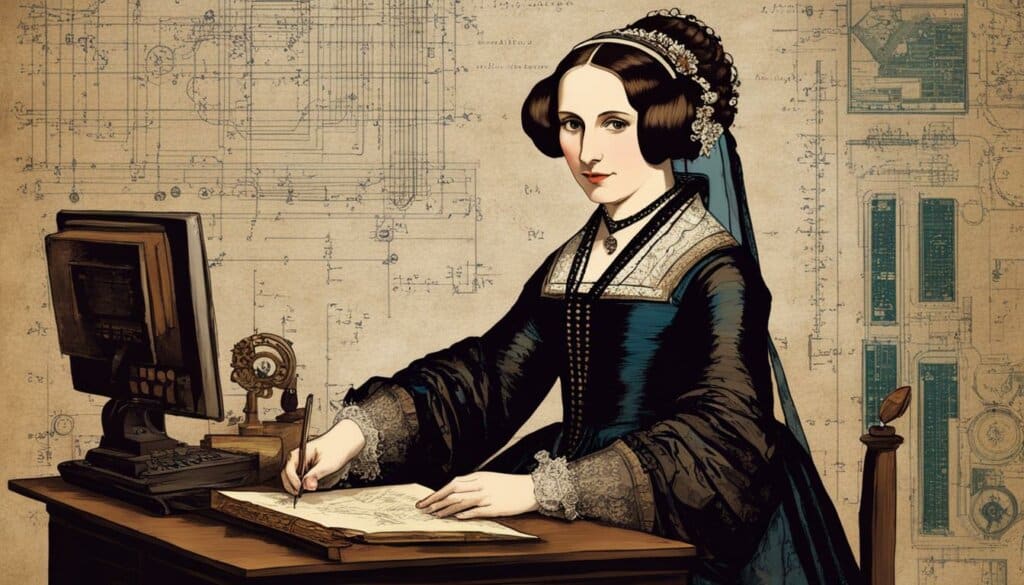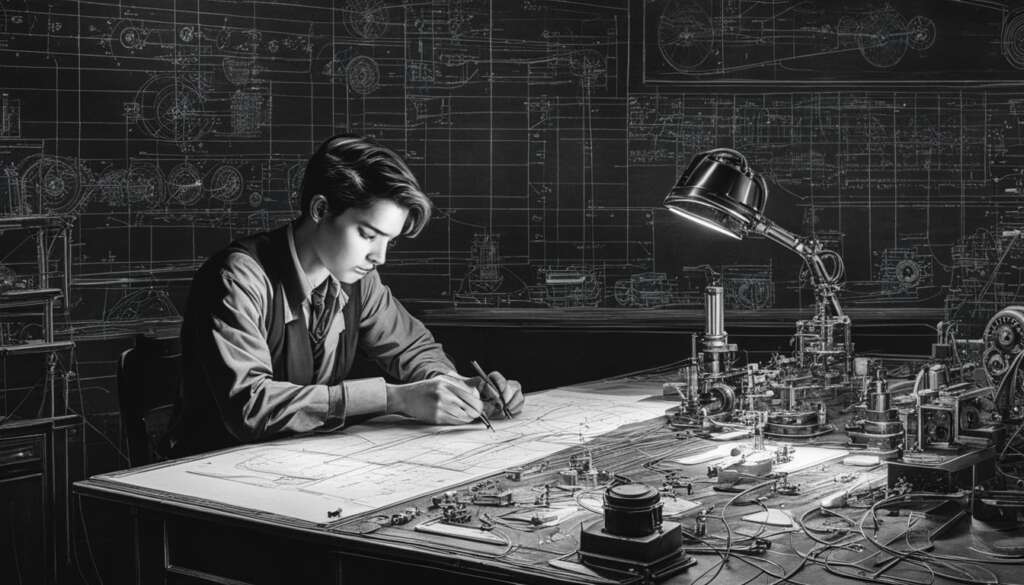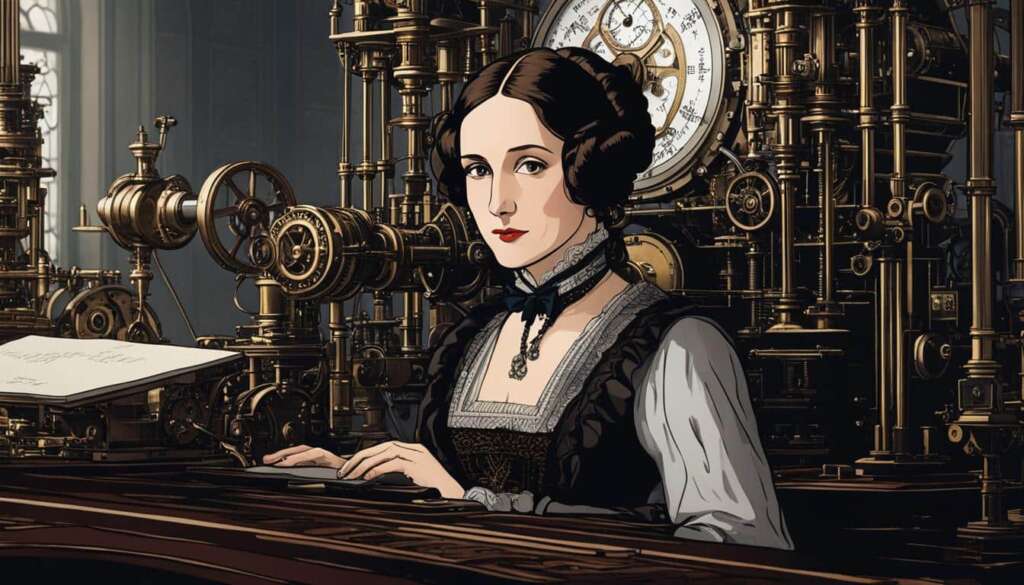Table of Contents
Ada Lovelace, often described as the world’s first computer programmer, was a trailblazer in the field of computing. Born on December 10, 1815, Lovelace’s contributions to computer science continue to shape the industry to this day. Her collaboration with mathematician Charles Babbage and her remarkable insights into the potential of early computers laid the foundation for modern computer programming.
As a mathematician and visionary, Ada Lovelace recognized the analytical engine, designed by Charles Babbage, as more than just a machine for numerical calculations. She understood its potential to manipulate symbols and perform complex tasks beyond basic computations.
Lovelace’s translation of a French article about Babbage’s analytical engine, along with her extensive annotations, showcased her understanding of the machine’s capabilities. In fact, her notes included a step-by-step description for computing Bernoulli numbers, marking her as the first computer programmer in history.
Ada Lovelace’s visionary thinking and her early contributions to computer science have had a profound impact on the industry. Her legacy continues to inspire women in technology and her work serves as a testament to the power of imagination and innovation in the realm of computer science.
Ada Lovelace’s Early Life and Education
Ada Lovelace, born as Augusta Ada Byron, was the only legitimate child of Lord Byron and Lady Anne Isabella Milbanke Byron. Raised by her mother, Lovelace received a rigorous education in mathematics and logic.
Under the guidance of renowned mathematicians and scientists, including Augustus De Morgan and Mary Somerville, Lovelace’s education encompassed a wide range of subjects, from algebra to astronomy. She developed a deep understanding of mathematics and explored its potential applications.
It was through her mentor, Mary Somerville, that Lovelace became acquainted with Charles Babbage and his innovative calculating machines. She had the opportunity to learn about “The Difference Engine” and the groundbreaking “Analytical Engine,” which would shape the future of computing.
Ada Lovelace’s Collaboration with Charles Babbage
Ada Lovelace collaborated closely with Charles Babbage on the development of the Analytical Engine. She not only understood the complexities of the machine but also recognized its potential beyond basic calculations. Lovelace’s visionary understanding of the Analytical Engine’s capabilities led her to write the first computer algorithm. Her algorithm showcased the machine’s ability to manipulate symbols and perform tasks beyond numerical calculations. This collaboration between Lovelace and Babbage marked a significant moment in the history of computing and laid the foundation for modern computer programming.

- Collaboration: Ada Lovelace and Charles Babbage worked closely together, combining Lovelace’s mathematical knowledge and Babbage’s technical expertise to push the boundaries of computer programming.
- Visionary Algorithm: Lovelace’s algorithm for the Analytical Engine showcased the machine’s potential for symbol manipulation and tasks beyond numerical calculations, pioneering the field of computer programming.
- Historical Significance: The collaboration between Lovelace and Babbage marked a significant moment in the history of computing, setting the stage for future advancements and shaping the way we approach programming today.
Ada Lovelace’s collaboration with Charles Babbage on the Analytical Engine was groundbreaking. Her visionary understanding of the machine’s capabilities and her development of the first computer algorithm laid the foundation for modern computer programming. Lovelace’s contributions continue to inspire and shape the field of technology, showcasing the importance of collaboration and pushing the boundaries of what is possible.
The Analytical Engine and Lovelace’s Algorithm
The Analytical Engine, although never fully constructed during Charles Babbage’s lifetime, was a revolutionary invention that paved the way for modern computing.
Ada Lovelace’s algorithm for the Analytical Engine went beyond basic mathematical instructions. Her algorithm introduced the concepts of symbolic logic, looping, and conditional branching, which are fundamental to modern programming. Lovelace’s algorithm demonstrated that the Analytical Engine could be programmed to perform tasks beyond numerical calculations, making her the world’s first computer programmer.
Ada Lovelace’s Contributions to Computer Science
Ada Lovelace’s impact on computer science goes far beyond her groundbreaking algorithm for the Analytical Engine. Her visionary thinking and insights into the potential of computing machines have shaped the field and continue to inspire future generations of computer scientists.
One of Lovelace’s significant contributions was her recognition of the creative possibilities that computing machines held. She understood that computers could be used for more than just numerical calculations. Lovelace envisioned them as tools for composing music and creating art, foreshadowing the use of computers in the fields of digital art and multimedia.
Lovelace’s forward-thinking ideas also left an indelible mark on hardware design for computers. She understood the need for adaptable and versatile machines that could handle different tasks. Her influence on hardware design can be seen in the development of modern computers, which are built to accommodate a wide range of applications and functionalities.
Additionally, Lovelace’s work laid the foundation for programming languages. Her algorithm for the Analytical Engine introduced concepts such as looping, conditional branching, and symbolic logic – fundamental elements of modern programming. Her contributions to programming languages have paved the way for the development of high-level languages that make coding more accessible and efficient.
Ada Lovelace’s pioneering spirit and innovative ideas continue to impact computer science and technology today. Her insights into computational thinking, hardware design, and programming languages have shaped the field’s trajectory and inspired countless individuals to pursue careers in computer science.

Ada Lovelace’s Contributions to Computer Science
| Contributions | Description |
|---|---|
| Creative Applications | Lovelace recognized the potential for using computing machines in creative tasks like music composition and art creation. |
| Hardware Design | Her visionary thinking influenced the development of versatile and adaptable hardware designs for computers. |
| Programming Languages | Lovelace’s algorithm introduced fundamental concepts that formed the foundation of modern programming languages. |
Lovelace’s Legacy and Impact on Women in Technology
Despite her work being largely unrecognized during her lifetime, Ada Lovelace has become an inspirational figure, especially for women in STEM fields. Her contributions to computer science and her status as the first computer programmer have gained recognition in recent years. Lovelace’s legacy extends beyond her technical achievements; she shattered gender stereotypes and proved that women could excel in technology and science. Her influence on women in technology continues to inspire and encourage more girls to pursue careers in STEM fields.
In a time when women were often discouraged from pursuing careers in STEM, Lovelace’s groundbreaking work served as a beacon of hope and empowerment. She defied societal expectations and fearlessly explored the possibilities of computing machines. Lovelace’s visionary contributions not only paved the way for advancements in computer science but also challenged the deeply ingrained gender biases prevalent in the field.
“The more I study mathematics, the more I am convinced of the value of women in the field. If only for its undeniable beauty, the pursuit of scientific knowledge deserves to be open to all.”
Lovelace’s remarkable journey continues to inspire women to defy stereotypes and pursue their passions in STEM. Her story serves as a reminder that gender should never be a barrier to achievement. Through her pioneering spirit and unwavering dedication, Lovelace shattered gender stereotypes and paved the way for future generations of women in technology.
Today, women in technology continue to draw inspiration from Ada Lovelace’s legacy. Her courage and perseverance serve as a testament to the limitless potential of women in the field. By highlighting Lovelace’s accomplishments, we can encourage and empower more girls and women to pursue careers in STEM fields, creating a more diverse and inclusive future for technology.
Accessing Lovelace’s Archive and Uncovering Her Genius
Much of Ada Lovelace’s archive remains relatively unknown, with only a fraction of her letters published and her writings largely inaccessible. However, thanks to the dedicated efforts of Jessica Cook, a UCLA doctoral candidate, Lovelace’s extensive archive is being transcribed to make her work more accessible to researchers and the public.
The archive contains a wealth of handwritten documents that provide a fuller picture of Lovelace’s genius beyond her contributions to computing. These precious writings offer valuable insights into Lovelace’s thoughts, ideas, and groundbreaking work. Transcribing these documents not only preserves Lovelace’s legacy but also allows for a deeper understanding of her remarkable intellect.
“The archive serves as a window into Lovelace’s mind and the origins of computer science,” says Cook. “Transcribing her handwritten documents is a labor-intensive process, but it is essential in ensuring broader access to her work and unraveling the depths of her genius.”
Transcribing the archive is an arduous task that requires meticulous attention to detail. To expedite the process and enhance accuracy, Cook is employing artificial intelligence to assist in transcribing the handwritten documents. This cutting-edge technology aids in deciphering Lovelace’s intricate handwriting and ensures greater accessibility to her words for future researchers.
Uncovering Hidden Gems
The transcribed archive will shed light on Lovelace’s lesser-known works, revealing additional dimensions to her groundbreaking ideas. From personal correspondences to scientific musings, these manuscripts hold the key to unlocking Lovelace’s genius and expanding our knowledge of early computing.
- Personal letters: Lovelace’s letters provide glimpses into her personal life, relationships, and the influences that shaped her thinking.
- Scientific notebooks: These notebooks contain Lovelace’s annotations, calculations, and ideas that contributed to the development of the Analytical Engine.
- Essays and speeches: Lovelace’s writings cover a wide range of topics, including the potential of computing machines and the role of imagination in scientific discovery.
By transcribing and analyzing these handwritten documents, researchers and enthusiasts can gain a more comprehensive understanding of Lovelace’s pioneering contributions to science, mathematics, and computation.
Conclusion
Ada Lovelace, the computing pioneer, has left an enduring legacy in the field of computer science. Her visionary thinking and remarkable contributions as the world’s first computer programmer continue to shape and inspire the world of technology. Lovelace’s pioneering work in understanding the potential of computing machines has led to significant advancements in programming, hardware design, and computational thinking.
Lovelace’s visionary mindset enabled her to see beyond the limitations of early computers, envisioning their potential for creative tasks like music composition and art. Her groundbreaking algorithm for the Analytical Engine paved the way for modern programming concepts, introducing symbolic logic, looping, and conditional branching.
Ada Lovelace’s influence extends beyond her technical achievements. She shattered gender stereotypes and proved that women can excel in technology and science. Lovelace serves as an inspiration, particularly for women in STEM fields, encouraging more girls to pursue careers in computing.
Lovelace’s legacy persists in the world of technology, inspiring innovation and emphasizing the power of imagination and vision in the field of computer science. Her contribution remains a testament to the enduring impact of visionary thinking in shaping the future of computing.
FAQ
Who was Ada Lovelace?
Ada Lovelace, born as Augusta Ada Byron, was the world’s first computer programmer and a computing pioneer. She was the daughter of English poet Lord Byron and received a scientific education that nurtured her mathematical talent. Lovelace collaborated with mathematician Charles Babbage on his calculating machines, including the groundbreaking Analytical Engine.
What is the Analytical Engine?
The Analytical Engine was a calculating machine conceptualized by Charles Babbage. Although it was never fully constructed during his lifetime, the Analytical Engine was a revolutionary invention that laid the foundation for modern computing. Ada Lovelace’s algorithm for the Analytical Engine showcased its potential for tasks beyond numerical calculations.
How did Ada Lovelace contribute to computer programming?
Ada Lovelace’s collaboration with Charles Babbage on the Analytical Engine led to her development of the first computer algorithm. Her algorithm went beyond basic mathematical instructions and introduced concepts like symbolic logic, looping, and conditional branching—fundamentals of modern programming. Lovelace’s work paved the way for future advancements in programming.
Where can I find Ada Lovelace’s contributions to computer science?
Ada Lovelace’s contributions to computer science, including her pioneering algorithm for the Analytical Engine, can be found in her extensive archive. Although much of her archive remains relatively unknown, efforts are being made to transcribe and make her work more accessible to researchers and the public.
What is Ada Lovelace’s legacy?
Ada Lovelace’s legacy extends beyond her technical achievements. She shattered gender stereotypes and became an inspirational figure for women in technology. Her visionary thinking and understanding of the potential of computing machines continue to inspire and shape the field of computer science.
How does Ada Lovelace inspire women in technology?
Ada Lovelace’s accomplishments as the world’s first computer programmer have gained recognition in recent years. Her pioneering contributions and success in a male-dominated field serve as a testament to the power of women in technology. Lovelace continues to inspire and encourage more girls to pursue careers in STEM fields.
How can I access Ada Lovelace’s archive?
Transcription efforts are currently underway to make Ada Lovelace’s extensive archive more accessible. Jessica Cook, a UCLA doctoral candidate, is utilizing artificial intelligence to assist in transcribing the handwritten documents, providing greater access and understanding of Lovelace’s genius beyond her contributions to computing.
What is Ada Lovelace’s contribution to computer science?
Ada Lovelace’s contributions to computer science include her development of the first computer algorithm and her visionary understanding of the potential of computing machines. She influenced advancements in programming, hardware design, and computational thinking, laying the foundation for modern computer science.













